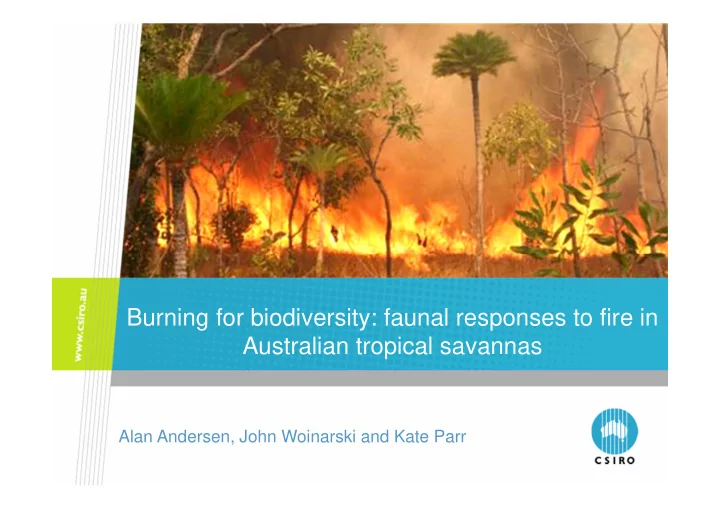

Burning for biodiversity: faunal responses to fire in Australian tropical savannas Alan Andersen, John Woinarski and Kate Parr
Tropical savanna faunas
Tropical savanna faunas
Fire in Australia’s tropical savannas
Small mammal decline across the north
Small mammal decline in Kakadu
Severe range contraction in the rabbit rat Conilurus penicillatus
The Kapalga fire experiment Kakadu National Park 0 10 Kilometres
0 Kilometres The Kapalga fire experiment 10 15 20 0 5 10 PRE-BURN FEB '89 MAY '89 FEB '90 MAY '90 FEB '91 Annual Early Unburnt Annual Late MAY '91 FEB '92 POST- BURN MAY '92 FEB '93 MAY '93 FEB '94 MAY '94 FEB '95 MAY '95
The Kapalga fire experiment Number of Number species affected by fire 11 1 16 5 25 4 0 10 Kilometres
The Kruger long-term fire experiment ������ �������� ��������� ������ ������� ������� ��������� ������ ������������ ���������� �������� ���������
Ant diversity in relation to fire at Kruger NP (Parr 2004) Mopane woodland (450 mm)
Ant diversity in relation to fire at Kruger NP (Parr 2004) Acacia savanna (550 mm)
Ant diversity in relation to fire at Kruger NP (Parr 2004) Acacia savanna (550 mm) ���������� ����������� ���������
Fire and birds at Kruger “(Birds) are likely to be robust to all but the most extreme fire policies. A hands-off fire policy is unlikely to affect bird communities negatively” M. S. L. Mills (2005), Koedoe
Fire and biodiversity in tropical savannas • Biota extremely resilient • Very limited pyrodiversity needed
Small mammal decline across the north
The Kapalga fire experiment 600 Total captures 400 200 0 1989-90 1990-91 1991-92 1992-93 1993-94 1994-95 Years Early Late Progressive Unburnt 0 10 Kilometres
Experimental translocation of rabbit rats Rabbit-rat story – experimental translocation fire
Rabbit-rat extinction modeling Fire regime Likelihood of extinction (within 10 years) No fire 78% Late dry fire every 10 years 89% Late dry fire every 3 years 97% Late dry fire every year 100%
Fire interactions with other threatening processes
Fire management for small mammal conservation
Fire management for small mammal conservation
Burning for savanna biodiversity: research priorities 1. Identifying species with special pyrodiversity requirements
What species prefer and what species need FROM: “My species X does best under fire regime Y, and so the conclusion from my study is that fire regime Y should be implemented”
What species prefer and what species need FROM: “My species X does best under fire regime Y, and so the conclusion from my study is that fire regime Y should be implemented” TO: “What taxa that are under threat at the landscape scale by prevailing fire regimes, and need special management attention?”
Burning for savanna biodiversity: research priorities 1. Identifying species with special pyrodiversity requirements 2. Within-fire patchiness
Burning for savanna biodiversity: research priorities 1. Identifying species with special pyrodiversity requirements 2. Within-fire patchiness 3. Fire/cat interaction and small mammal declines in Australia
Burning for savanna biodiversity: research priorities 1. Identifying species with special pyrodiversity requirements 2. Within-fire patchiness 3. Fire/cat interaction and small mammal declines in Australia 4. Carbon/biodiversity trade-offs
Recommend
More recommend